How to Grow and Care for Chickpeas
Growing chickpeas for hummus does not require a tropical climate.
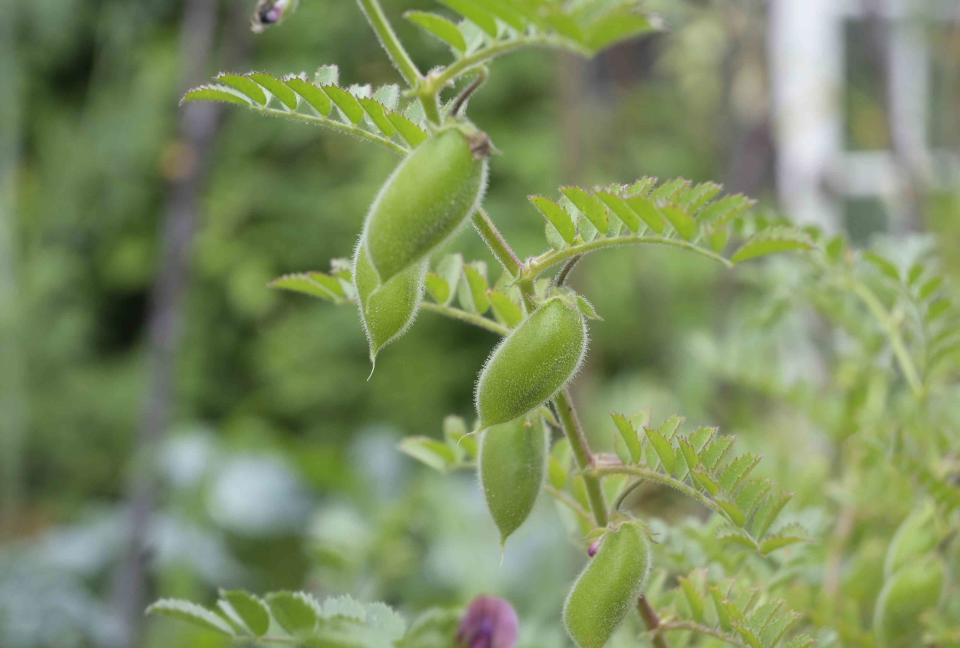
The Spruce / Randi Rhoades
Reviewed by Kathleen Miller
What we call chickpeas or garbanzo beans are legumes, but they aren’t botanically peas (Pisum sativum). The annual plants are bushy and short. Like tomatoes, chickpeas are indeterminate, they continue to grow new leaves after they have started to flower—in purple, white, pink, or blue color depending on the chickpea variety. The chickpeas grow in small seed pods. They are green when fresh though most chickpeas are harvested after the seeds have dried on the plant and turned tan or brown in color. Chickpeas are widely used in Mediterranean, Middle Eastern, and Indian cuisine.
Chickpeas are planted in the spring and harvested in the late summer after a long growing season. However, you don’t need to live in a tropical climate to grow your own chickpeas for hummus; in fact, chickpeas prefer moderately warm summers.
Common Name | Chickpea, garbanzo bean |
Botanical Name | Cicer arietinum |
Family | Fabaceae |
Plant Type | Annual, vegetable |
Mature Size | 8-24 in. tall and wide |
Sun Exposure | Full sun |
Soil Type | Loamy, sandy, well-drained |
Soil pH | Acidic |
Bloom Time | Spring |
Hardiness Zones | 3-9 (USDA) |
Native Area | Asia, Africa, Middle East |
How to Plant Chickpeas
When to Plant
Chickpeas are planted when the soil temperature in the spring has warmed up to at least 50 degrees F. After that, they need a long, warm growing season. If you live in a cold climate, you should get a head start on the outdoor growing season to increase the chance that the plants reach maturity before the end of the summer. Start chickpeas indoors two to four weeks before your average last frost date, as long as you use coir or paper pots that let you transplant them into the garden without disturbing the roots.
Selecting a Planting Site
A location in full sun with well-draining, fertile soil is a must for chickpeas. Make sure you follow crop rotation rules and don’t plant chickpeas in the same place where you grew other legumes the year before.
Chickpeas lend themselves to outdoor container-growing on a sunny patio or porch.
Spacing, Depth, and Support
Plant the chickpeas 4 inches apart. The planting depth varies, 1 inch for small-seeded and 2 inches for large-seeded varieties. Chickpeas are bush-type plants and by planting them densely they support each other, making staking or trellising unnecessary.
Chickpea Plant Care
When grown in the right conditions, chickpeas don’t require much care and they are moderately easy to grow.
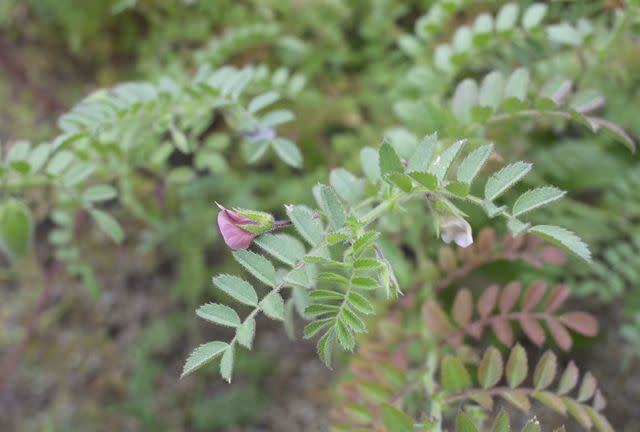
The Spruce / Randi Rhoades
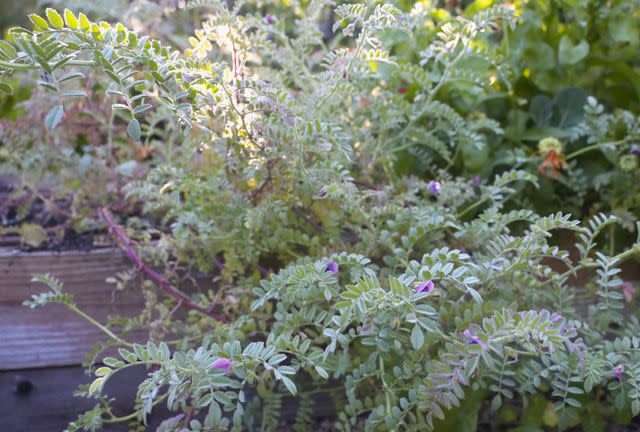
The Spruce / Randi Rhoades
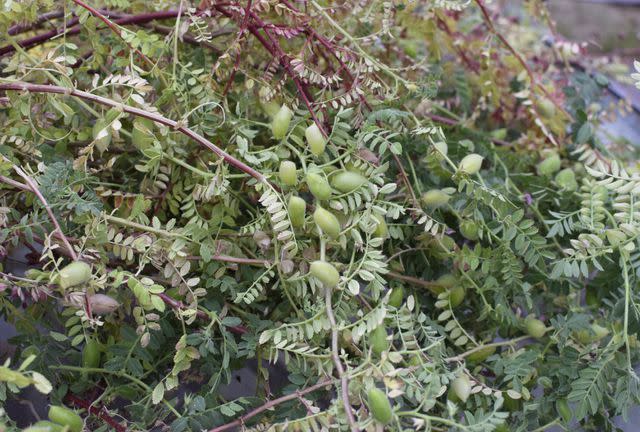
The Spruce / Randi Rhoades
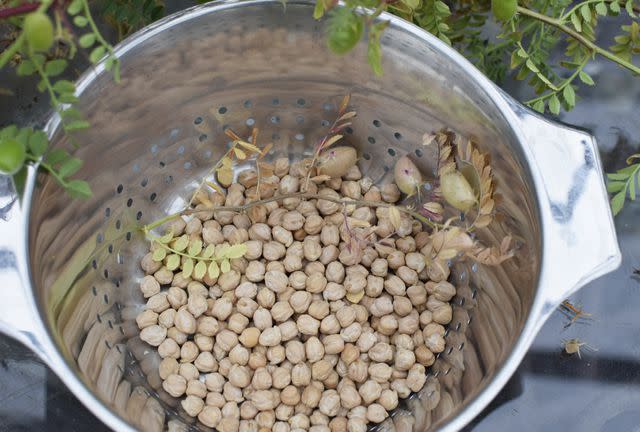
The Spruce / Randi Rhoades
Light
Chickpeas need a spot that gets 6 to 8 hours of sun daily. In hot southern climates, the plants do better with afternoon shade.
Soil
The soil should be nutrient-rich with plenty of organic matter and have excellent drainage. Chickpeas grow in a pH range from 5.3 to 7, around 6.0 is ideal.
Water
To grow chickpeas, the soil needs to be evenly moist at all times. If it does not rain, give the plants about an inch of water per week in areas with moderately warm summers. In hot climates, they need more water until the top 2 inches of soil feel moist. Water the plants slowly and deeply to reach the root. Drip irrigation is best.
Temperature and Humidity
Chickpeas need warm weather but they are not a hot-weather crop, they do best in daytime temperatures between 70 and 80 degrees F and nighttime temperatures between 65 to 70 degrees F. Moderate humidity does not bother the plants. In cool climates, an early fall frost cuts the growing season short if the chickpeas haven’t fully matured yet.
Fertilizer
Chickpeas are nitrogen-fixing legumes so any fertilizer you apply should be high in phosphorus, potassium, and micronutrients yet not in nitrogen, which promotes foliage growth. If you start with rich, fertile soil, you might not need a fertilizer at all. To avoid overfertilizing, lightly sprinkle some granular organic fertilizer in a circle around the plants every six weeks, taking care not to get fertilizer on the stems.
Pollination
Chickpeas self-pollinate and don’t require insects for pollination.
The 13 Best Places to Buy Seeds in 2023
Types of Chickpeas
The two main types of chickpeas are Kabuli and Desi.
Kabuli are small- to large-seeded chickpeas and these plants usually are taller than Desi. Kabuli chickpeas have white to cream-colored seed coats and white flowers.
Desi chickpeas are small and have a tan or brown pigmented seed coat. Desi chickpeas have purple flowers and they mature a week or two earlier than Kabuli chickpeas.
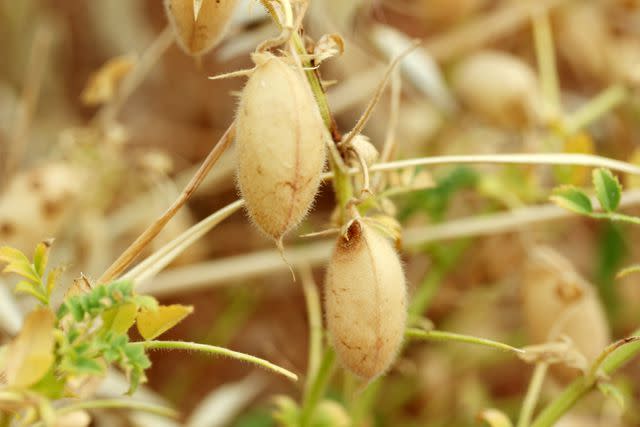
SafakOguz / Getty Images
Dried chickpea pods close to harvest harvestHarvesting Chickpeas
Depending on the weather conditions, chickpeas are ready to be harvested in 85 to 100 days after planting, in the late summer. You can harvest them when the pods are still small and green and prepare them like snap beans.
The most common way of harvesting them is waiting for the leaves to wither, dry, and brown, then pull the entire plant including the roots. Place the plant on a flat surface in a warm, dry, well-ventilated location such as a garage. Let it dry further until the pods start to split and the seeds inside are visible. Remove the seeds from their pods.
Before being stored, the chickpeas must be treated to kill any insects and their eggs. To do this in the oven, distribute the chickpeas in a single layer on a baking sheet and pasteurize them at 160 degrees Fahrenheit for 30 minutes. Or, place the chickpeas in freezer bags and leave them in the freezer at 0 degrees Fahrenheit or below for at least 48 hours. Afterward store the chickpeas in an airtight container in a cool, dry place.
How to Grow Chickpeas in Pots
Because chickpea plants are short and bushy, they lend themselves to container-growing. Use a container with large drainage holes and well-draining potting mix. Just like chickpeas in a garden setting, start with more plants and thin out the 3-inch seedlings so you end up with a maximum of four plants per square foot. Also, keep in mind that container plants need more frequent watering and fertilizer applications than plants in garden soil. Feed the plants about once a month with a granular organic low-nitrogen fertilizer.
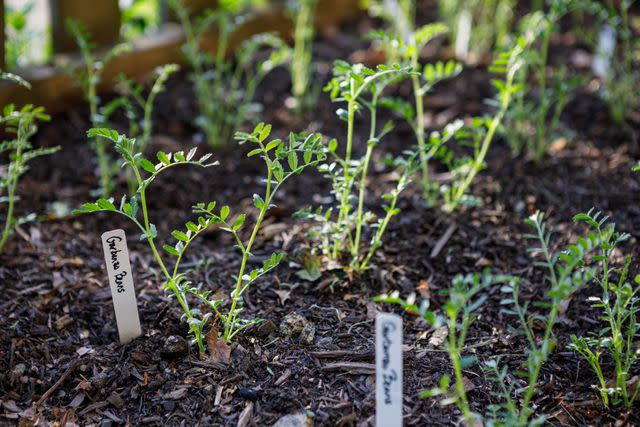
eurobanks / Getty Images
Chickpea seedlingsPruning
While chickpeas do not require pruning, they need to be thinned out. When the seedlings are 3 inches tall, cut any extra seedlings at the surface level to leave 6 inches of space between each plant. Do not pull out the seedlings like you’d pull weeds because that disturbs and potentially damages the roots of the plants you want to keep.
Propagating Chickpeas
As chickpeas are an annual crop with a long growing season, there is no point in propagating the plant vegetatively to produce new plants in the same growing season. Instead, set aside some chickpeas from your harvest to use as seeds the next year.
How to Grow Chickpeas From Seed
Chickpeas should not be soaked before planting. The use of an inoculant, however, is generally recommended. Treating a legume seed with an inoculant ensures that the correct type of beneficial nitrogen-fixing bacteria is available to the plant when it germinates. Different legumes require different bacteria; in the case of chickpeas, you need Mesorhizobium ciceri or M. mediterraneum. Inoculants are available from garden supply companies.
After you have planted the chickpeas—1 to 2 inches deep and 4 inches apart—water them thoroughly and keep the soil evenly moist. The seeds should sprout within 10 to 21 days depending on weather conditions.
If you have started the seeds indoors, plant them in the garden with their pots when the soil has warmed and any danger of frost has passed.
Overwintering
Chickpeas are an annual crop. The plants die after the harvest so overwintering is unnecessary.
Common Pests and Plant Diseases
Because chickpea leaves, stems, and pods are hairy and secrete malic acid, insects tend to leave the plants alone.
Like other legumes, chickpeas are prone to fungal diseases such as Ascochyta blight, Rhizoctonia root rot, Pythium rot, Fusarium wilt, white mold, bacterial blight, as well as certain viruses which are transmitted by aphids. These diseases are often exacerbated by high humidity, hot temperatures, and lots of rain. Prevent spreading problems with proper plant spacing to ensure air circulation and avoid overhead watering.
Frequently Asked Questions
Can you grow chickpeas indoors?
Chickpeas are not suitable for indoor growing. They need full sun and even in optimal light conditions indoors, the plants will likely become leggy.
Are chickpeas and garbanzo beans the same?
Yes, they are botanically the same plant. The name garbanzo bean comes from the Spanish term for dried seeds (“garau antzu”).
Can you use chickpeas from the grocery store as seeds?
You can get store-bought chickpeas to sprout but unlike chickpeas from a seed company where you know the days to maturity and other specific growing requirements, you don’t know which type you are getting. Therefore using them for growing your own chickpeas might be hit-or-miss.
Read the original article on The Spruce.

